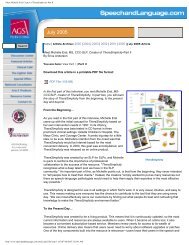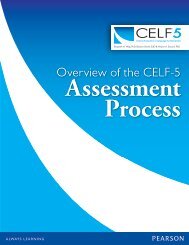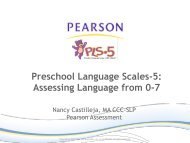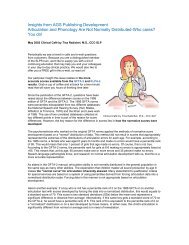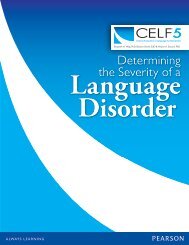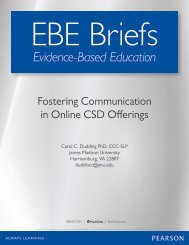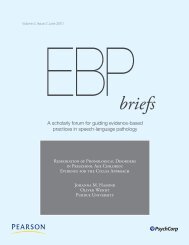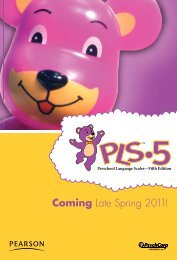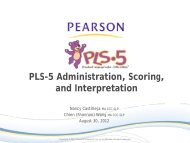You can download a PDF of the slides - Speech and Language
You can download a PDF of the slides - Speech and Language
You can download a PDF of the slides - Speech and Language
You also want an ePaper? Increase the reach of your titles
YUMPU automatically turns print PDFs into web optimized ePapers that Google loves.
Preschool <strong>Language</strong> Scales-5:<br />
Assessing <strong>Language</strong> from 0-7<br />
Nancy Castilleja, MA CCC-SLP<br />
Pearson Assessment<br />
Copyright © 2007 Pearson Education, inc. or its affiliates. All rights reserved.<br />
Friday, May 6, 2011
Course Objectives<br />
• identify three key differences between<br />
PLS-4 <strong>and</strong> PLS-5<br />
• describe two research studies conducted<br />
with <strong>the</strong> PLS-5<br />
• describe at least two principles identified<br />
by ASHA as best practices in early<br />
language assessment<br />
Friday, May 6, 2011<br />
Copyright © 2007 Pearson Education, inc. or its affiliates. All rights reserved.
Test Purpose:<br />
Identify young children (ages birth to 7:11) who have a language delay<br />
or disorder<br />
Friday, May 6, 2011<br />
Copyright © 2007 Pearson Education, inc. or its affiliates. All rights reserved.
New in PLS-5<br />
• Current norms for a wider age range: based on <strong>the</strong> 2008<br />
update <strong>of</strong> <strong>the</strong> U.S. Census for children birth through 7:11<br />
• Streamlined administration, with new suggested start points<br />
<strong>and</strong> test items that involve manipulatives grouped for<br />
smoo<strong>the</strong>r transitions during testing<br />
• Improved test items, based on clinician <strong>and</strong> field testers’<br />
feedback<br />
• New Growth Scale Values! Evidence-based scores you <strong>can</strong><br />
use to track progress<br />
• Updated Articulation Screener with picture stimuli<br />
Friday, May 6, 2011<br />
Copyright © 2007 Pearson Education, inc. or its affiliates. All rights reserved.
What skills does PLS-5 target?<br />
Assess a wide range <strong>of</strong> communication skills<br />
– Preverbal skills<br />
• Attention to environment <strong>and</strong> people<br />
• Play<br />
• Vocal development<br />
• Social communication<br />
• Gesture<br />
– <strong>Language</strong> content <strong>and</strong> structure<br />
• underst<strong>and</strong>ing <strong>and</strong> using concepts<br />
• Underst<strong>and</strong>ing <strong>and</strong> using morphosyntactic forms<br />
– Integrative language skills (thinking using language)<br />
• Analogies<br />
• Similes<br />
• Categories<br />
• Semantic absurdities<br />
• Theory <strong>of</strong> Mind<br />
– Emergent literacy<br />
• Book h<strong>and</strong>ling<br />
• Phonological awareness<br />
Friday, May 6, 2011<br />
Copyright © 2007 Pearson Education, inc. or its affiliates. All rights reserved.
Age Range <strong>and</strong> Administration Time<br />
• Age range: Now birth through 7:11<br />
– Use normed scores for children through age 7<br />
– Use as a criterion-referenced tool for older elementary age<br />
children functioning at <strong>the</strong> birth to 7:11 age range<br />
– Not appropriate for use with secondary students or adults<br />
functioning at a language age <strong>of</strong> birth through 7:11<br />
• Administration time:<br />
– Birth through 11 months: 25-35 minutes<br />
– 12 through 35 months: 45-55 minutes<br />
– 3:0 through 4:11: 50-60 minutes<br />
– 5:0 through 7:11 40-50 minutes<br />
– New start points reduce administration time<br />
Friday, May 6, 2011<br />
Copyright © 2007 Pearson Education, inc. or its affiliates. All rights reserved.
Test Kit <strong>and</strong> Manipulatives<br />
Friday, May 6, 2011<br />
Copyright © 2007 Pearson Education, inc. or its affiliates. All rights reserved.
Organization <strong>of</strong> <strong>the</strong> Test<br />
Norm-referenced Scales<br />
Supplemental Measures<br />
• Auditory Comprehension Scale<br />
• Expressive Communication Scale<br />
• <strong>Language</strong> Sample Checklist<br />
• Articulation Screener<br />
• Home Communication<br />
Questionnaire<br />
Copyright © 2007 Pearson Education, inc. or its affiliates. All rights reserved.<br />
Friday, May 6, 2011
Home Communication Questionnaire<br />
Friday, May 6, 2011<br />
Copyright © 2007 Pearson Education, inc. or its affiliates. All rights reserved.
Home Communication Questionnaire<br />
Friday, May 6, 2011<br />
Copyright © 2007 Pearson Education, inc. or its affiliates. All rights reserved.
Scores<br />
• Auditory Comprehension, Expressive<br />
Communication, <strong>and</strong> Total Communication<br />
– St<strong>and</strong>ard scores<br />
– Percentile ranks<br />
– Growth Scale Values (formerly called Progress Scores on<br />
<strong>the</strong> PLS-4 Measure <strong>of</strong> Progress)<br />
– Age equivalents<br />
• Articulation Screener<br />
– Research-based criterion scores by age<br />
Friday, May 6, 2011<br />
Copyright © 2007 Pearson Education, inc. or its affiliates. All rights reserved.
Friday, May 6, 2011<br />
Copyright © 2007 Pearson Education, inc. or its affiliates. All rights reserved.
Friday, May 6, 2011<br />
Copyright © 2007 Pearson Education, inc. or its affiliates. All rights reserved.
How different is PLS-5 from PLS-4?<br />
Approximately<br />
• 25% <strong>of</strong> <strong>the</strong> test items<br />
are new to PLS-5<br />
• 25% are unchanged<br />
• 50% have been<br />
modified in some way,<br />
with new art, new<br />
administration<br />
directions, or new<br />
practice items<br />
Friday, May 6, 2011<br />
Copyright © 2007 Pearson Education, inc. or its affiliates. All rights reserved.
New Test Items<br />
• For ages 18-24 months<br />
– additional items assessing play<br />
• For ages 3 through 4 years<br />
– new items assessing book<br />
h<strong>and</strong>ling <strong>and</strong> concept <strong>of</strong><br />
print<br />
• For ages 5 through 7 years<br />
– new items testing<br />
• Theory <strong>of</strong> Mind<br />
• Integrated language skills such as use <strong>of</strong> synonyms<br />
• Emergent literacy skills such as naming letters <strong>and</strong> underst<strong>and</strong>ing<br />
prefixes<br />
Friday, May 6, 2011<br />
Copyright © 2007 Pearson Education, inc. or its affiliates. All rights reserved.
New item: Uses synonyms<br />
Friday, May 6, 2011<br />
Copyright © 2007 Pearson Education, inc. or its affiliates. All rights reserved.
New Demonstration Item for Underst<strong>and</strong>s<br />
Size/Sequence Concepts (smallest, biggest)<br />
Friday, May 6, 2011<br />
Copyright © 2007 Pearson Education, inc. or its affiliates. All rights reserved.
New Practice item:<br />
Uses Possessive Pronouns: hers, his<br />
Friday, May 6, 2011<br />
Copyright © 2007 Pearson Education, inc. or its affiliates. All rights reserved.
New Practice Item:<br />
Underst<strong>and</strong>s noun + two adjectives<br />
Friday, May 6, 2011<br />
Copyright © 2007 Pearson Education, inc. or its affiliates. All rights reserved.
Revised practice item<br />
Friday, May 6, 2011<br />
Copyright © 2007 Pearson Education, inc. or its affiliates. All rights reserved.
Updated art<br />
Friday, May 6, 2011<br />
Copyright © 2007 Pearson Education, inc. or its affiliates. All rights reserved.
Assessing Theory <strong>of</strong> Mind<br />
• Theory <strong>of</strong> Mind<br />
– Capacity to underst<strong>and</strong> ano<strong>the</strong>r’s mental state<br />
to explain <strong>and</strong> predict o<strong>the</strong>rs’ behavior (Miller, 2006)<br />
– Child learns to take ano<strong>the</strong>r person’s<br />
perspective<br />
– Link between Theory <strong>of</strong> Mind <strong>and</strong><br />
communication (de Villiers & de Villiers, 2005)<br />
– Also important for comprehending narratives<br />
Copyright © 2007 Pearson Education, inc. or its affiliates. All rights reserved.<br />
Friday, May 6, 2011
Items integrating Theory <strong>of</strong> Mind<br />
concepts<br />
• Some items requiring that <strong>the</strong> child make<br />
inferences about ano<strong>the</strong>r’s feelings or<br />
intentions<br />
Friday, May 6, 2011<br />
Copyright © 2007 Pearson Education, inc. or its affiliates. All rights reserved.
Underst<strong>and</strong>ing false beliefs<br />
Friday, May 6, 2011<br />
Copyright © 2007 Pearson Education, inc. or its affiliates. All rights reserved.
Examples <strong>of</strong> streamlined administration<br />
<strong>of</strong> test items<br />
Friday, May 6, 2011<br />
Copyright © 2007 Pearson Education, inc. or its affiliates. All rights reserved.
Friday, May 6, 2011<br />
Copyright © 2007 Pearson Education, inc. or its affiliates. All rights reserved.
Modified Articulation Screener, now<br />
with visual stimuli<br />
Friday, May 6, 2011<br />
Copyright © 2007 Pearson Education, inc. or its affiliates. All rights reserved.
Changes from PLS-4 to PLS-5<br />
Item Administration <strong>and</strong> Scoring Changes<br />
– New! Start points reduce administration time<br />
• Examinees take fewer test items<br />
– All test stimuli are in <strong>the</strong> Record Form<br />
– Items retained from PLS-4 are similar, but some items have<br />
scoring changes<br />
• Example: Naming Categories item: as long as <strong>the</strong> child<br />
names at least six items in <strong>the</strong> category, he or she may<br />
name one or two items that are not in <strong>the</strong> category<br />
• Specifics will be posted on PLS-5.com in late Spring<br />
Friday, May 6, 2011<br />
Copyright © 2007 Pearson Education, inc. or its affiliates. All rights reserved.
Scoring<br />
Copyright © 2007 Pearson Education, inc. or its affiliates. All rights reserved.<br />
Friday, May 6, 2011
Scoring<br />
• Basal: 3 consecutive correct responses<br />
• Ceiling: 6 consecutive errors<br />
– Based on performance <strong>of</strong> children in <strong>the</strong><br />
st<strong>and</strong>ardization sample<br />
– Because PLS-5 tests a variety <strong>of</strong> skills, a child<br />
could obtain one or more score points if you<br />
discontinue testing earlier<br />
Friday, May 6, 2011<br />
Copyright © 2007 Pearson Education, inc. or its affiliates. All rights reserved.
St<strong>and</strong>ardization Research<br />
• Over 1800 children were tested for<br />
st<strong>and</strong>ardization <strong>and</strong> related reliability <strong>and</strong><br />
validity studies from December 2009<br />
through August 2010<br />
• The st<strong>and</strong>ardization sample was collected<br />
by 189 clinicians in 42 states in <strong>the</strong> United<br />
States<br />
Friday, May 6, 2011<br />
Copyright © 2007 Pearson Education, inc. or its affiliates. All rights reserved.
Technical Information<br />
– Demographic Information<br />
– Validity Studies<br />
• Clinical studies<br />
– Ages 1-2:11 language delay study<br />
– Ages 3:0-7:11 language disorder study<br />
– Sensitivity/specificity<br />
– Positive/negative predictive power<br />
• Correlations with o<strong>the</strong>r assessments<br />
– PLS-4<br />
– CELF Preschool-2<br />
– Reliability Studies<br />
• Inter-rater reliability: .95 to .98<br />
• Inter-scorer agreement: .91 to 1.0<br />
– Case studies<br />
• Autism<br />
• Hearing Impairment<br />
PLS-5 Sample: Race/Ethnicity<br />
Afri<strong>can</strong> Ameri<strong>can</strong> 14.2%<br />
Asian 4%<br />
Hispanic 23.9%<br />
White 53.7%<br />
Copyright © 2007 Pearson Education, inc. or its affiliates. All rights reserved.<br />
Friday, May 6, 2011
Sample mirrors March 2008 Update <strong>of</strong><br />
<strong>the</strong> U.S. Census: Race/Ethnicity<br />
Afri<strong>can</strong>-Ameri<strong>can</strong> 14%<br />
Asian 4%<br />
Hispanic 23%<br />
White 55%<br />
O<strong>the</strong>r 4%<br />
Friday, May 6, 2011<br />
Copyright © 2007 Pearson Education, inc. or its affiliates. All rights reserved.
Sample mirrors March 2008 Update <strong>of</strong><br />
<strong>the</strong> U.S. Census: Parent Education<br />
0-11 years 15%<br />
High School diploma or GED 26%<br />
1-3 years college or technical school 28%<br />
4 or more years <strong>of</strong> college 31%<br />
Friday, May 6, 2011<br />
Copyright © 2007 Pearson Education, inc. or its affiliates. All rights reserved.
Sample mirrors March 2008 Update <strong>of</strong><br />
<strong>the</strong> U.S. Census: Region<br />
PLS-5 Normative Sample: Region<br />
Nor<strong>the</strong>ast 19.7%<br />
Midwest 19.9%<br />
South 36.4%<br />
West 24%<br />
Friday, May 6, 2011<br />
Copyright © 2007 Pearson Education, inc. or its affiliates. All rights reserved.
Where Children in <strong>the</strong> PLS-5 Sample<br />
Spend <strong>the</strong> Majority <strong>of</strong> <strong>the</strong>ir Day<br />
Child's Learning Environment<br />
Home w/Family 56.4%<br />
Home w/Sitter 2.9%<br />
Day Care 16.4%<br />
Preschool 6.7%<br />
Kinder<br />
Grades 1-2<br />
O<strong>the</strong>r/NR<br />
Friday, May 6, 2011<br />
Copyright © 2007 Pearson Education, inc. or its affiliates. All rights reserved.
Are children with disabilities included in <strong>the</strong><br />
PLS-5 sample?<br />
Friday, May 6, 2011<br />
Copyright © 2007 Pearson Education, inc. or its affiliates. All rights reserved.
PLS-4/PLS-5 Correlations<br />
Friday, May 6, 2011<br />
Copyright © 2007 Pearson Education, inc. or its affiliates. All rights reserved.
CELF Preschool-2/<br />
PLS-5 Correlations<br />
Friday, May 6, 2011<br />
Copyright © 2007 Pearson Education, inc. or its affiliates. All rights reserved.
Clinical Study: Developmental Delay<br />
Friday, May 6, 2011<br />
Copyright © 2007 Pearson Education, inc. or its affiliates. All rights reserved.
Clinical Study: Receptive-Expressive Disorder<br />
Friday, May 6, 2011<br />
Copyright © 2007 Pearson Education, inc. or its affiliates. All rights reserved.
Sensitivity/Specificity:<br />
NPP/PPP with 50% Matched Sample<br />
AC EC Total<br />
Cut Score<br />
SD <strong>and</strong><br />
Predictive<br />
Power<br />
Matched<br />
Sample<br />
50%<br />
Matched<br />
Sample<br />
50%<br />
Matched<br />
Sample<br />
50%<br />
-1 SD<br />
PPP 0.83 0.86 0.81<br />
NPP 0.77 0.85 0.83<br />
-1.5 SD<br />
PPP 0.93 0.94 0.92<br />
NPP 0.66 0.75 0.74<br />
-2 SD<br />
PPP 0.96 0.95 0.94<br />
NPP 0.60 0.63 0.63<br />
Note. PPP is Positive Predictive Power <strong>and</strong> NPP is<br />
Negative Predictive Power.<br />
Copyright © 2007 Pearson Education, inc. or its affiliates. All rights reserved.<br />
Friday, May 6, 2011
Reliability: Test-Retest Stability (n = 127)<br />
• Testing interval: 3-28 days<br />
Friday, May 6, 2011<br />
Copyright © 2007 Pearson Education, inc. or its affiliates. All rights reserved.
Split Half Reliability (Internal Consistency)<br />
Friday, May 6, 2011<br />
Copyright © 2007 Pearson Education, inc. or its affiliates. All rights reserved.
Reliability: Internal Consistency<br />
Friday, May 6, 2011<br />
Copyright © 2007 Pearson Education, inc. or its affiliates. All rights reserved.
Reliability: Internal Consistency<br />
Friday, May 6, 2011<br />
Copyright © 2007 Pearson Education, inc. or its affiliates. All rights reserved.
Reliability: Inter-rater agreement<br />
Inter-rater study (n = 54)<br />
– Birth through 3:11<br />
• AC .96<br />
• EC .99<br />
• Total <strong>Language</strong> .98<br />
– 4:0 through 7:11<br />
• AC .96<br />
• EC .96<br />
• Total <strong>Language</strong> .96<br />
Friday, May 6, 2011<br />
Copyright © 2007 Pearson Education, inc. or its affiliates. All rights reserved.
Reliability: Inter-scorer Agreement<br />
Friday, May 6, 2011<br />
Copyright © 2007 Pearson Education, inc. or its affiliates. All rights reserved.
Roles <strong>and</strong> Responsibilities <strong>of</strong> SLPs in<br />
Early Intervention<br />
• www.asha.org/policy<br />
• Four guiding principles<br />
1. family-centered <strong>and</strong> culturally <strong>and</strong><br />
linguistically responsive<br />
2. developmentally supportive <strong>and</strong> promote<br />
participation in natural environments<br />
3. comprehensive, coordinated, <strong>and</strong> team based<br />
4. based on <strong>the</strong> highest quality evidence<br />
available<br />
Friday, May 6, 2011<br />
Copyright © 2007 Pearson Education, inc. or its affiliates. All rights reserved.
Family-centered <strong>and</strong> culturally <strong>and</strong><br />
linguistically responsive<br />
– Home Communication Questionnaire<br />
– Caregiver participation in testing<br />
– Caregiver-selected <strong>and</strong> caregiver-identified social<br />
routines <strong>and</strong> vocabulary tested for very young<br />
children<br />
– Extensive bias review <strong>and</strong> widespread testing with a<br />
diverse sample has resulted in<br />
– Familiar home vocabulary <strong>and</strong> contexts<br />
– Dialectal, regional, <strong>and</strong> cultural variations to<br />
target responses are accepted as correct<br />
Friday, May 6, 2011<br />
Copyright © 2007 Pearson Education, inc. or its affiliates. All rights reserved.
Developmentally supportive <strong>and</strong> promote<br />
participation in natural environments<br />
• Observation <strong>of</strong> naturally occurring behaviors for<br />
younger children<br />
• Credit given for spontaneous productions in <strong>and</strong><br />
outside <strong>the</strong> assessment room<br />
• Developmentally appropriate skills assessed<br />
Friday, May 6, 2011<br />
Copyright © 2007 Pearson Education, inc. or its affiliates. All rights reserved.
Comprehensive, coordinated, <strong>and</strong> team<br />
based<br />
• Provides a survey <strong>of</strong> language skills in <strong>the</strong> areas <strong>of</strong><br />
– Social communication<br />
– Semantics<br />
– Morphology<br />
– Syntax<br />
– Articulation<br />
• Useful for arena assessment; <strong>can</strong> be administered<br />
by pr<strong>of</strong>essionals in child development teams<br />
Friday, May 6, 2011<br />
Copyright © 2007 Pearson Education, inc. or its affiliates. All rights reserved.
Based on <strong>the</strong> highest quality evidence<br />
available<br />
• Current normative data<br />
• Literature review<br />
• Expert review<br />
Friday, May 6, 2011<br />
Copyright © 2007 Pearson Education, inc. or its affiliates. All rights reserved.
Questions?<br />
Copyright © 2007 Pearson Education, inc. or its affiliates. All rights reserved.<br />
Friday, May 6, 2011
How do I fit <strong>the</strong> bear <strong>and</strong> pitcher in <strong>the</strong><br />
box?<br />
Friday, May 6, 2011<br />
Copyright © 2007 Pearson Education, inc. or its affiliates. All rights reserved.
How do I make <strong>the</strong> duck squeak loud?<br />
Friday, May 6, 2011<br />
Copyright © 2007 Pearson Education, inc. or its affiliates. All rights reserved.
The duck won’t have a loud squeak<br />
when…<br />
Copyright © 2007 Pearson Education, inc. or its affiliates. All rights reserved.<br />
Friday, May 6, 2011
How do I know whe<strong>the</strong>r to use PLS-5 or CELF<br />
Preschool-2?<br />
• Overview <strong>of</strong> developmental language<br />
skills in many areas<br />
• Ages birth through 7:11<br />
• Can assess preverbal children <strong>and</strong><br />
children with low language ability<br />
• Can assess children functioning in<br />
supported classroom environments<br />
(such as Early Childhood <strong>and</strong><br />
classrooms for children with pervasive<br />
developmental delays such as autism)<br />
• In-depth assessment <strong>of</strong> semantics,<br />
morphology, syntax<br />
• Ages 3:0 through 6:11<br />
• Assess children who speak in complete<br />
sentences<br />
• Assess children functioning in mainstream<br />
classrooms<br />
Both assessments target language skills; both point to intervention goals<br />
Friday, May 6, 2011<br />
Copyright © 2007 Pearson Education, inc. or its affiliates. All rights reserved.


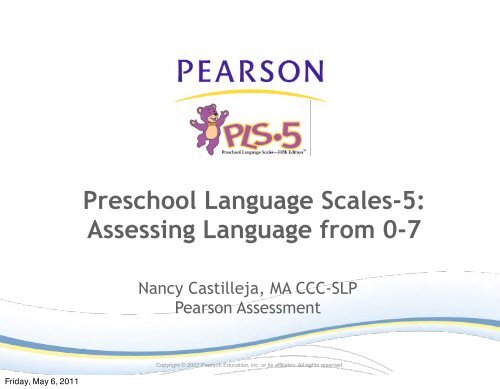
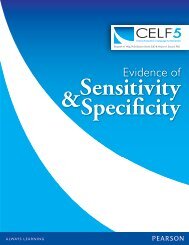
![EBP Brief V1 Issue 1 [8x10].indd - Speech and Language](https://img.yumpu.com/51068713/1/190x238/ebp-brief-v1-issue-1-8x10indd-speech-and-language.jpg?quality=85)

